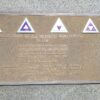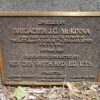2/1st Pioneer Battalion
The men of the 2/1st hailed from New South Wales and the battalion itself was raised in Sydney in May 1940. An interesting fact about the 2/1st is that two of its sergeants had served in WWI in the 1st Pioneer Battalion. By the end of 1940 the 2/1st along with other Australian Corps Support Units from Sydney to the Middle East. The convoy travelled from Suez, to Palestine and then to Tobruk, where they came under the control of the 6th Division. Where the battalion helped to restore the port, repair roads and salvage engineering material. The 2/1st advanced to Derna, in an effort to maintain the road between the 2 bases.
Due to Axis troops advancing east, leading British troops in the area to fall back to Tobruk, where the 2/1st were already stationed. In an effort to slow the Axis troops a Battalion Lieutenant destroyed the Derna Pass, once the last of the Allied troops had arrived. By the end of the next day all the Pioneer Battalions had arrived in Tobruk.
For five months the 2/1st helped defend Tobruk. Over these brutal months Tobruk had cot the Battalion heavily; as 37 men were KIA, 7 mortally wounded, 9 became POW and 68 more men were wounded. Like many of the Australian Defenders in the region the 2/1st were evacuated in Spetember 1941.
After a stint back home in Australia, the 2/1st were shipped out to Papua New Guinea. Where A, B, and C companies moved through the base of the Kokoda Trail, through Uberi and finally reaching Ioribaiwa. Where the 3 companies manned defensive positions to protect Imita Ridge. In November the 3 companies were moved to 9 – mile Quarry. Where they worked as miners and labourers for seven months; producing crushed metal for use in paving roads and airfields. During this time D Company was working to develop infrastructure in the area of Milne Bay, by building Trestle bridges and maintaining roads.
The men of the 2/1st fought in the events of the Battle for Tobruk, Imita Ridge Operations and the Kokoda Trail Campaign; they also received the battle honours of the Defence of Tobruk and The Salient 1941.
2/2nd Pioneer Battalion
In May of 1940 the 2/2nd Pioneer Battalion was raised in Puckapunyal, Victoria. After completing basic training, the battalion boarded the Queen Mary in April 1941 and sailed for the Middle East. After travelling through the region, they arrived in Syria and began preparing for their first conflict; supporting the 7th Division.
Interestingly, the battalion did not initially fight as a whole, each company fought separately, supporting a separate brigade. A Company went on to support the 21st Brigade at Er Rama and B Company supported the 25th Brigade near Rosh Pinah. When the attack began on the 7th of June under the new command of the 2/16th Infantry A company had three main tasks; breach the frontier fence at El Malakiya, and improve transport infrastructure in the area. B company had similar duties in Metulla. After joining the 25th Brigade D company did similar work by assisting in the maintenance of roads and bridges; days later C company advanced to their position from Er Rama.
The 2/2nd battalion was involved the events of Ramu Valley-Finisterres Operations and the Syrian Campaign, and received the Battle Honours of Damour, Lae Road, Mazaraat ech Chouf, Merjayun, Ramu Valley, Shaggy Ridge and Syria 1941 over the course of the Second World War.
2/3rd Pioneer Battalion
The 2/3rd Pioneer Battalion was made mostly from men in the Sydney area, and was raised in May 1940 at Glenfield. After extensive training and travelling across Australia, the 2/3rd sailed from Sydney to the Middle East aboard the Queen Mary in November of 1941 (Interestingly, the Queen Mary would carry them home 14 months later). After a few months in the Middle East the 2/3rd moved to Syria and joined the 9th Division, whom they would fight alongside for the rest of the war.
By mid-1942 the warfront in the North African region came to be a critical point for the British Eight Army. In turn the 9th division was diverted from Syria to El Alamein, a position they held for four months holding back German and Italian forces. In the areas known as “Saucer” and the “Blockhouse” the 2/3rd played a major role in a heavy fighting operation alongside the 26th and 24th Brigade, as well as a number of British Tanks. The 2/3rds role was to take up a defensive position and block the enemy near the coast. After an arduous battle they achieved their goal and sealed of the coastal region from the enemy forces.
Between the period of August to November the 2/3rd suffered a significant amount of loses; 28 killed and 46 captured. Although the battle at Alamein was vital for the allies and a major turning point in the war. Consequently the 9th Division was recalled home to face the Japanese and the 2/3rd then returned to Australian in 1943.
After a short leave the 2/3rd returned to action fighting the Japanese, a would remain doing so until the end of the war. The battalion was key in taking over the Tarakan region. By the end of the war the Battalion received the battle honours of Borneo, Capture of Lae, Defence of Scarlet Beach, El Alamein, Finschafen, Siki Cove and Tarakan.
2/4th Pioneer Battalion
The 2/4th Pioneer Battalion was raised in February 1941 at the Greta Army Camp. After basic training they Battalion arrived in Darwin during September 1941, and established a main headquarters at Noonmah. The Battalion’s companies dedicated their time to work on defensive positions on the mainland (i.e. Adelaide River to Darwin.)
In 1942 the 2/4th was transferred to Timor. However due to extensive Japanese bombings the 2/4th was forced to return home following the Fall of Singapore. Their bad luck continued however as when they returned to Darwin harbour the ship was sunk by the Japanese the next day, along with all their equipment.
The 2/4th went on for 13 months defending locations in they Darwin area, until they were relieved in 1943. After a short leave and some more training, the battalion was sent overseas to support the 9th Division and the landing in Borneo. The 2/4th only received 5 casualties in the Borneo operation. During the official surrender ceremonies for the Japanese the 9th Division was responsible for carrying out a number of arrangements in various locations, while the 2/4th became responsible for the Kuching region; becoming the “Kuching Force”. The 2/4th only received one battle honour, Borneo.
The memorial inscription reads:
IN MEMORY OF ALL MEMBERS WHO SERVED IN THE
2/1ST AUSTRLAIN PIONEER BATTALION
2/2ND AUSTRLAIN PIONEER BATTALION
2/3RD AUSTRLAIN PIONEER BATTALION
2/4TH AUSTRLAIN PIONEER BATTALION
DURING WORLD WAR 2 – 1940 – 1945BATTLE HONOURS
MIDDLE EAST PALESTINE TOBRUK SYRIA EL ALAMEIN
JAVA NEW GUIEA KOKODA MILNE BAY LAE FINSCHHAFEN
NADZAB SHAGGY RIDGE
MOROTAI TARAKAN BALIKPAPAN LABUAN DARWINLEST WE FORGET






Comments